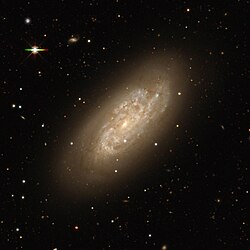Astronomy:NGC 1792
| NGC 1792 | |
|---|---|
 NGC 1792 with the legacy surveys | |
| Observation data (J2000 epoch) | |
| Constellation | Columba |
| Right ascension | 05h 05m 14.454s[1] |
| Declination | −37° 58′ 50.70″[1] |
| Redshift | 0.004059[2] |
| Helio radial velocity | 1,208[3] |
| Distance | 36.4 Mly (11.17 Mpc)[3] |
| Group or cluster | NGC 1808[4] |
| Apparent magnitude (V) | 10.18[2] |
| Apparent magnitude (B) | 10.68[2] |
| Characteristics | |
| Type | SA(rs)bc[5] |
| Mass | 0.54×1011[6] M☉ |
| Mass/Light ratio | 3.4[6] M☉/L☉ |
| Other designations | |
| IRAS 05035-3802, NGC 1792, PGC 16709, MCG -6-12-004, ESO 305-6, ESO LV3050060[2] | |
NGC 1792 is a spiral galaxy located in the southern Columba constellation. It was discovered by Scottish astronomer James Dunlop on October 4, 1826. This galaxy is located at a distance of about 36.4 million light-years and is receding from the Milky Way with a heliocentric radial velocity of 1,208 km/s.[3] NGC 1792 is a member of the NGC 1808 cluster of galaxies.[4]
The morphological classification of this galaxy in the de Vaucouleurs system is SA(rs)bc,[5] indicating a spiral galaxy with no central bar (SA), moderately wound arms (bc), and an incomplete ring structure.[5] However, the HyperLEDA classification of SBbc suggests it does have a bar. It has a flocculent appearance with no central bulge.[7] In the B-band, the angular extend of the galaxy spans 7′.5 × 3′.1. The plane of the galaxy is inclined at an angle of 66° to the line of sight from the Earth, with the major axis being aligned along a position angle of 317°.[4]
File:NGC1792 - HST - Potw2049a.tif There is a high level of star formation along the spiral arms at distances of more than 3 kpc from the galactic core, which have led to a number of prominent H II regions. A comparable high level of star formation in the nearby NGC 1808 galaxy may indicate a recent, distant tidal interaction between the two.[8] Radio emission from the neutral hydrogen in the NGC 1792 galaxy shows a pronounced asymmetry, most likely as a result of this interaction. As the galaxy appears only slightly disturbed, this interaction mainly impacted the outer parts of the galaxy.[4]
The star formation rate in NGC 1792 is estimated to be 11.0 M☉·yr−1.[6] Soft x-ray emission has been detected, the majority of which may be coming from X-ray binaries.[9]
References
- ↑ 1.0 1.1 Skrutskie, Michael F. et al. (1 February 2006). "The Two Micron All Sky Survey (2MASS)". The Astronomical Journal 131 (2): 1163–1183. doi:10.1086/498708. ISSN 0004-6256. Bibcode: 2006AJ....131.1163S.
- ↑ 2.0 2.1 2.2 2.3 "NGC 1792". SIMBAD. Centre de données astronomiques de Strasbourg. http://simbad.u-strasbg.fr/simbad/sim-basic?Ident=NGC+1792.
- ↑ 3.0 3.1 3.2 Tully, R. Brent et al. (2016). "Cosmicflows-3". The Astronomical Journal 152 (2): 21. doi:10.3847/0004-6256/152/2/50. 50. Bibcode: 2016AJ....152...50T.
- ↑ 4.0 4.1 4.2 4.3 Dahlem, M. (October 1992). "NGC 1792 : surprising radio properties.". Astronomy and Astrophysics 264: 483–488. Bibcode: 1992A&A...264..483D.
- ↑ 5.0 5.1 5.2 de Vaucouleurs, G. et al. (1991). Third reference catalogue of bright galaxies. 9. New York: Springer-Verlag.
- ↑ 6.0 6.1 6.2 Dahlem, M. et al. (July 2001). "A search for intergalactic H I gas in the NGC 1808 group of galaxies". Astronomy and Astrophysics 373 (2): 485–493. doi:10.1051/0004-6361:20010614. Bibcode: 2001A&A...373..485D.
- ↑ Marino, A. et al. (February 2010). "Galaxy evolution in Local Group analogs. I. A GALEX study of nearby groups dominated by late-type galaxies". Astronomy and Astrophysics 511: 18. doi:10.1051/0004-6361/200913216. A29. Bibcode: 2010A&A...511A..29M.
- ↑ Dahlem, M. et al. (July 2001). "A search for intergalactic H I gas in the NGC 1808 group of galaxies". Astronomy and Astrophysics 373 (2): 485–493. doi:10.1051/0004-6361:20010614. Bibcode: 2001A&A...373..485D.
- ↑ Dahlem, Michael et al. (September 1994). "Soft X-Ray Observations of the Interacting Galaxies NGC 1808 and NGC 1792". Astrophysical Journal 432: 598. doi:10.1086/174598. Bibcode: 1994ApJ...432..598D.
External links
| Wikimedia Commons has media related to NGC 1792. |
http://www.skyfactory.org/deepskycatalogue/db_list.asp?q=(Name~contains~NGC1792)
Coordinates: ![]() 5h 14m 6.7s, −40° 2′ 48″
5h 14m 6.7s, −40° 2′ 48″
 |

